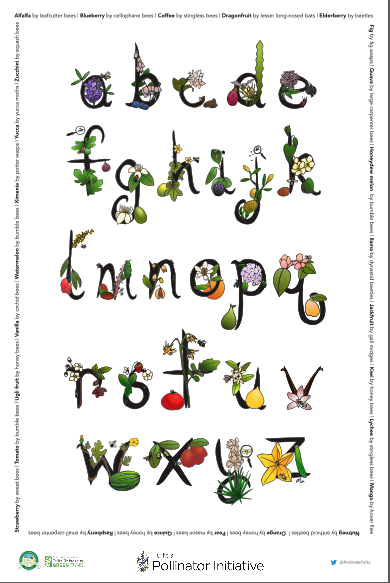
Flowering plants face a problem: how do they find a mate if they can’t move? Over millions of years, they have formed intricate relationships with animals to solve this problem.
Animals are lured to flowers with the promise (usually) of sweet nectar. Upon drinking their fill, animals carry away minute pollen grains on their bodies and subsequently deposit those grains at different flowers. This is pollination: the transfer of pollen from the anthers of one flower to the stigma of another. If successful, the pollen grain will fertilize the flower ovary, resulting in a seed.
Three-quarters of the top global food crops require pollination from animals. Most people think of honey bees as important crop pollinators and, while this is true, countless other animals are also responsible for your nutritious (and colorful) diet. Solitary bees, stingless bees, hover flies, wasps, beetles, moths, and even bats are all crop pollinators!
We commissioned artist Mae Humiston to create The Pollination Alphabet to highlight the diversity of crops and their pollinators from A to Z. It is easy to assume grocery stores will always have fresh fruit, but in a world without insects, most of these fruits could not be grown. We hope to raise awareness of the ecological, economic, and cultural value behind the food on the plates of both you and animal pollinators.
Below, you’ll find brief descriptions of the pollination system of each crop in the alphabet.
Crops featured in the alphabet
| Alfalfa | Blueberry | Coffee | Dragonfruit |
| Elderberry | Fig | Guava | Honeydew |
| Ilama | Jackfruit | Kiwi | Lychee |
| Mango | Nutmeg | Orange | Pear |
| Quince | Raspberry | Strawberry | Tomato |
| Ugli Fruit | Vanilla | Watermelon | Ximenia |
| Yucca | Zucchini | Glossary |
Alfalfa
Alfalfa (Medicago sativa) is pollinated by alfalfa leaf-cutter bees (Megachile rotundata). Most humans don’t directly eat alfalfa, but the protein-rich legume feeds dairy cows, which in turn give us milk, cheese, and ice cream. Alfalfa leaf-cutter bees were introduced to the United States from Europe in the 1930s to help ensure high seed set in alfalfa crops. These bees are the best—better than honey bees—at manipulating the complex alfalfa flowers to collect pollen, which is why alfalfa farmers throughout central North America rent leaf-cutter bees for their fields. Each season, more than 40,000 bees are deployed per acre of alfalfa! Top
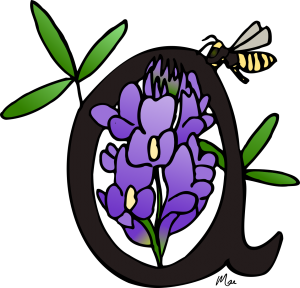
Blueberry
Blueberry (Vaccinium spp.) is pollinated by cellophane bees (Colletes validus). Blueberry is a beloved summertime treat, with a flavor unmatched by any other fruit on the market. Cellophane bees are ground-nesting solitary bees that specialize on blueberry pollen and nectar. They synchronize their emergence in spring with the blueberry bloom and have evolved a longer face in order to reach the nectar deep within the goblet-shaped flowers. Even more, cellophane bees are capable of buzz-pollinating the flowers in order to release the pollen, which is locked away in tube-like anthers. Many other bees are also excellent blueberry pollinators including bumble bees, mining bees, mason bees, and carpenter bees. Pollination by wild bees consistently increases the quality, yield, and market value of blueberry. Top
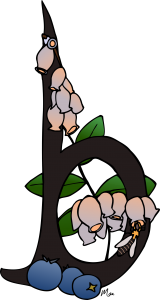
Coffee
Coffee (Coffea arabica) is pollinated by stingless bees (Meliponini). Native to the highlands of Ethiopia, but now grown throughout the tropics, coffee is an understory plant of the rainforest. Flushes of fragrant, white flowers bloom simultaneously, attracting hordes of stingless bees. Like honey bees, stingless bees are social, make honey, and live in hives where all the workers are descended from a single queen. True to their name, they cannot sting. Instead, their defense mechanism is to bite the offender. Following pollination, each coffee ovary swells into a scarlet berry containing two large seeds. The seeds are carefully harvested, processed, and roasted into what we know as coffee beans. Although coffee is self-fertile, insect pollination increases fruit set. The benefit of bees to coffee farmers provides an incentive to maintain pollinator friendly farms by planting a diverse overstory and flower-rich farm edges. Top
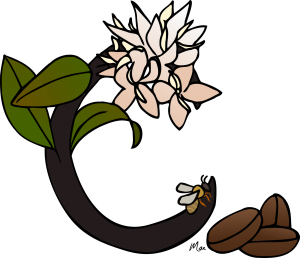
Dragonfruit
Dragonfruit (Stenocereus spp. and Hylocereus spp.) is pollinated by long-nosed bats (Leptonycteris spp.). Dragonfruit is a vining cactus originally native to Central America, but is cultivated throughout the world for its ornamental and culinary intrigue. Dragonfruit is both a beautiful and frustrating crop to grow: its enormous white, fragrant flowers bloom at night, and only for eight hours. In the morning, the flower wilts on the vine. Throughout its native range, dragonfruit is pollinated by bats that are attracted to the huge flowers, beacons in an otherwise dark desert. Bats hover in front of flowers, lap up the sweet, copious nectar, and depart with a snout dusted in pollen. And a visit from a bat is worth it: bat pollination increases the size, sweetness, and value of dragonfruits. Top
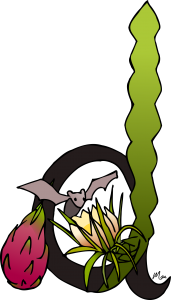
Elderberry
Elderberry (Sambucus spp.) is pollinated by long-horned beetles (Cerambicidae). Elderberry plants blanket wet roadsides and weedy stream banks throughout Europe and the United States. Beetles and flies (rather than bees) are attracted to the umbrella-like inflorescences, the scientific term for a collection of flowers. Each elderberry inflorescence is made up of hundreds of flowers, each tiny and white, with a dandelion-button center and a musky scent. Long-horned beetles crash land on the inflorescence and romp through the field of flowers. They drink nectar and spread pollen, but often eat or break other flower parts in the process. While most of the elderberry plant is toxic, the flowers and fruits (once cooked) are not. Flowers can be turned into St. Germain liqueur and the berries are prized by those that practice traditional medicine for syrups and tinctures. Top
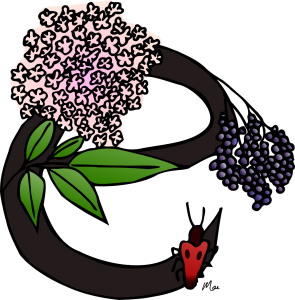
Fig
Fig (Ficus spp.) is pollinated by fig wasps (Agaonidae). Figs are an incredibly diverse group of plants in the tropics. All of them engage in a highly specialized relationship with their pollinators. Fig flowers are housed inside of a structure called a syconium, which looks like a smaller version of a fig fruit. The syconium is both where pollination and fig wasp reproduction occurs. The cycle starts when a female fig wasp, laden with pollen, squeezes into the syconium through an opening so small that she loses her wings in the process. Once inside, she deposits pollen on the receptive stigmas, lays eggs in a portion of the fig ovaries, and dies. The next generation of fig wasps develops inside. Males emerge first, blind and wingless. They mate, chew exit holes for the females (how chivalrous!), then die. The mated female pick up fresh pollen before departing to find another syconium, thus completing the cycle. Wild figs are pollinated by wasps, but commercial figs can be grown in the absence of insect pollinators. So, don’t worry, you’re not eating dead wasps when you eat figs. At least, not usually 🙂 Top
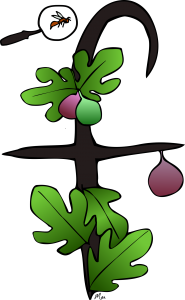
Guava
Guava (Psidium guajava) is pollinated by carpenter bees (Xylocopa spp.). Guava is a popular tropical fruit, grown throughout the tropics for its intense flavor, high nutrition, and culinary versatility. Guava fruits are enjoyed fresh off the tree (by humans, birds, and monkeys), sliced as a snack with cheese, or in syrups, pies, and salsas. Throughout its range, guava is pollinated by wild carpenter bees, which expertly handle the large, frilly flowers. Research suggests that while carpenter bees are reliable pollinators of guava, managed honey bees are also excellent. Scientists recommend that a combination of wild and managed bees should be used to maximize guava production. Top
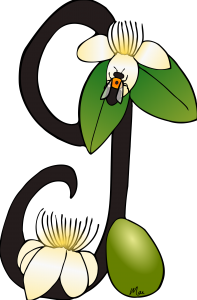
Honeydew
Honeydew (Cucumis melo) is pollinated by bumble bees (Bombus spp.). Honeydew is a domesticated variety of the muskmelon—just like cantaloupe and Armenian cucumber—meaning humans played an important role in shaping the fruit we eat today. Many enjoy honeydew fresh with a slice of prosciutto, blended in a savory gazpacho, or in sorbet. Honeydew flowers are monoecious, meaning male and female flower parts are housed in separate flowers on the same plant. Bumble bees are experts at visiting male and female flowers in sequence, thus ensuring successful melon production. Top
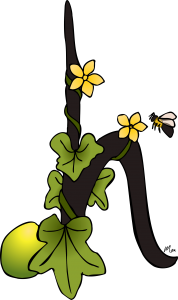
Ilama
Ilama (Annona diversifolia) is pollinated by scarab beetles (Dynastinae). Ilama is an obscure tropical fruit from Central America related to soursops, cherimoyas, and pawpaws. It has an excellent flavor, but trees bear fruit inconsistently and the fruits do not transport well, hence its anonymity in global markets. Ilama flowers are designed to satisfy their fussy beetle pollinators. In contrast to bees that make quick visits to flowers, beetles stake claim to particular flowers and stay put for hours or days on end. Upon arrival, beetles deposit pollen on receptive stigmas. Then, ilama flowers begin the slow process of making pollen. To keep the beetles around until the anthers have matured, ilama flowers feed beetles thick, nutritious petals. The flower is also warm and scented, and the petals curl around the top to create a dark chamber, both of which are features that ensure the beetles stick around long enough to depart with a load of pollen. Top
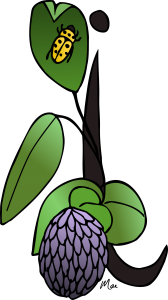
Jackfruit
Jackfruit (Artocarpus heterophyllus) is pollinated by gall midges (Cecidomyiidae). Jackfruit is large, tropical fruit with a hard, spiky rind and stringy, yellow flesh. If you’ve never had jackfruit, find some today: they are tasty raw, in a smoothie, or as a meat-substitute in sandwiches! Jackfruit does not produce nectar to attract its pollinator. Instead, it relies on a fungus and dose of deception. Female gall midges lay eggs on fungus-infected male jackfruit flowers where her babies feast on the fungus. Female jackfruit flowers attract gall midges by mimicking the odor of a fungus-infected male flower, offering the hollow promise of a breeding site. This trickery is so effective that female gall midges carry pollen from the male flowers to the female flowers and complete pollination. It is remarkable the role that fungus plays in jackfruit pollination: without fungus, flies are not attracted to jackfruit, and jackfruit fails to produce fruit. Jackfruit’s pollination system is so bizarre it only became known to scientists in 2018! Top
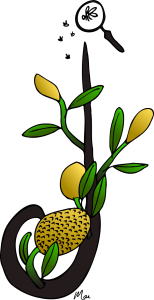
Kiwi
Kiwi (Actinidia deliciosa) is pollinated by honey bees (Apis mellifera). Although delicious, kiwi is a tricky plant to cultivate on a large scale due to its pollination biology. Kiwi flowers are dioecious, meaning male and female flowers are housed on separate plants. Bees have to visit at least two plants to make a kiwi and must deposit thousands of pollen grains in order to set fruit. However, neither male nor female kiwi flowers produce nectar. Male kiwi flowers produce viable, protein-rich pollen, but female kiwi flowers produce sterile, nutrition-less pollen. Honey bees visit both male and female kiwi flowers for pollen alone, but can be easily distracted by nearby nectar-laden flowers. Scientists have developed a tool to spray-pollinate kiwi flowers as a workaround to the difficulty of relying on insects to mass-pollinate kiwi on farms. Top
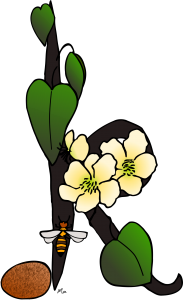
Lychee
Lychee (Litchi chinensis) is pollinated by stingless bees (Tetragonula spp.). Lychee are distinctive tropical fruits that look like bumpy, crimson golf balls. They have a slippery, white flesh (think: peeled grape) that’s sweet and tart. Small stingless bees have been shown to effectively cross-pollinate lychee on farms in Australia, but they have to navigate lychee’s complex floral biology to do so. Flowers open in three waves. First, male flowers produce nectar and pollen to attract and feed insect visitors. However, pollen produced by these first male flowers is sterile and cannot set fruit. Second, female flowers open and become receptive to pollen. Last, another wave of male flowers arrives, and the pollen produced by these flowers is viable. Thus, growers must ensure that their lychee orchard produces both female and viable male flowers simultaneously. Top
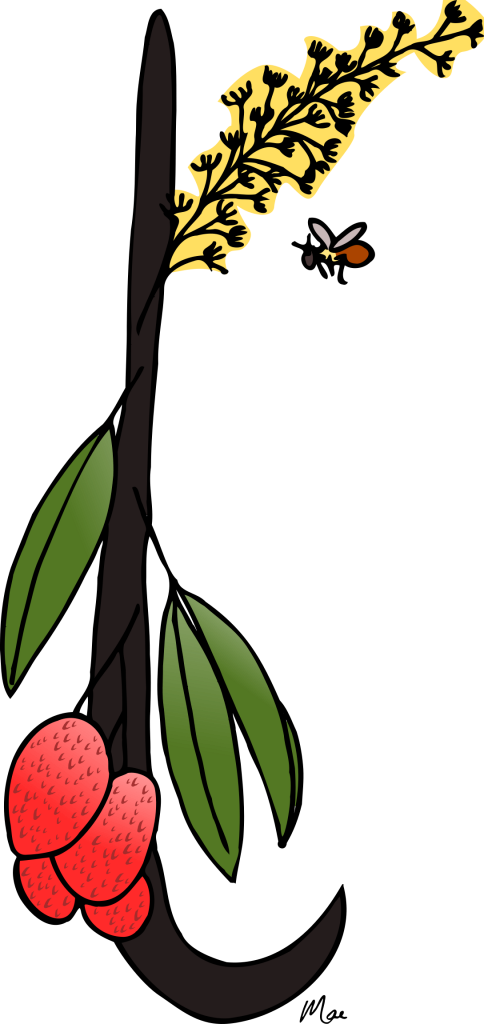
Mango
Mango (Mangifera indica) is pollinated by hover flies (Syrphidae). It’s hard to not love a mango. The national fruit of India, mangoes originated in southeast Asia, but are now grown all over the world to be eaten raw, sliced into salad, blended into smoothies, or added to delicious pies. Although we eat three main varieties in the US, there are hundreds of mango varieties grown throughout the world that differ in color, size, and flavor. Mango flowers are presented on long, trailing inflorescences that are highly attractive to insects. Hover flies are excellent pollinators of mango, but also other insects like lacewings, gnats, and even ants are potentially important players in mango reproduction. Top
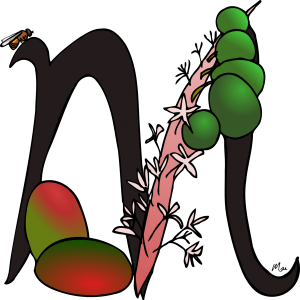
Nutmeg
Nutmeg (Myristica fragrans) is pollinated by ant-mimicking flower beetles (Anthicidae). You probably know the flavor of nutmeg from fall-themed foods like chutney, pies, curries, and, of course, pumpkin-spice lattes. In each of these cases, nutmeg plays an important supporting role. Likewise, its pollinators—nocturnal flower beetles that look like ants—are unassuming but essential. Nutmeg trees are dioecious with creamy-white, fragrant flowers on both male and female trees. Flowers open at night when other insects are not active. Pollen is the reward from male trees, and ant-mimicking beetles consistently depart male nutmeg trees carrying large loads of pollen. Female flowers lack a reward altogether. Beetles are tricked into visiting stigmas by an enticing fragrance. Top
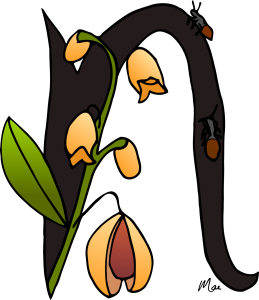
Orange
Orange (Citrus x sinensis) is pollinated by honey bees (Apis mellifera). Citrus and humans have a long history, from citron and lemons serving as a status symbol in the Roman Empire to orange production becoming a multi-billion dollar industry in Florida during the 20th century. Like much of the citrus we eat, oranges are a genetic tangle. They are the result of natural and artificial tinkering between citrus varieties that resulted in the perfectly sweet fruit we enjoy at breakfast. Unfortunately, this perfection comes at a cost. All oranges are essentially clones of one another, meaning they are highly susceptible to disease and the future of oranges as we know them is in jeopardy. Orange flowers aren’t dependent on insect pollination; they are self-fertile and will produce fruit without bees. But, having bees on farms can increase yield and, for beekeepers, the nectar produced by orange flowers is an important food source for their colonies. Plus, orange blossom honey is delicious! Top
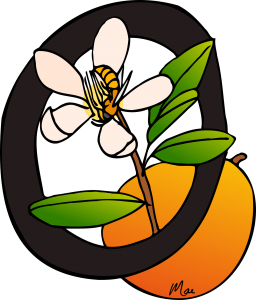
Pear
Pear (Pyrus communis) is pollinated by mason bees (Osmia spp.). Like apples, we enjoy dozens of different varieties of pears (but there’s no Johnny Pear-seed to thank). Each variety arose from a chance mutation in a pear ancestor that produced a desirable quality such as improved flavor or longer shelf life. To maintain these traits, growers cloned the varieties. Thus, all trees of a particular variety, like Anjou or Bartlett, are genetically identical. Each of these varieties requires non-self pollen—pollen that is not genetically identical to the stigma—to set fruit, and therefore must be cross-pollinated with a different pear variety. Solitary mason bees get the job done. They are good pear pollinators because they are active during the short bloom season and will fly in cold spring conditions. Furthermore, mason bees have a preference for pear pollen over other spring flowers like dandelions and, for that reason, ensure a higher fruit set compared to other bees. Top
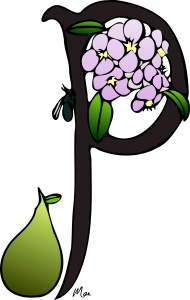
Quince
Quince (Cydonia oblonga) is pollinated by honey bees (Apis mellifera). Quince are an odd fruit. They share no immediate relatives, though they are part of the apple and rose family. They are oblong, bruise easily, and have a tough, starchy flesh that can only be made edible by long poaching. Once softened, however, quince are a real treat. Spoon them over yogurt or cook them down into preserves. Choose ones in the grocery store that have a sweet fragrance. Quince flowers are highly attractive to honey bees and they are its chief pollinator throughout the world, though many varieties are also self-compatible. Top
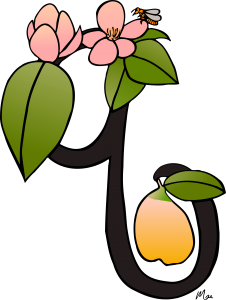
Raspberry
Raspberry (Rubus spp.) is pollinated by small carpenter bees (Ceratina spp.) Raspberries are highly attractive to pollinating insects and require pollination to set fruit. Small carpenter bees are interesting pollinators because they use raspberry plants for both food and shelter*. These solitary bees hollow out old, broken raspberry canes into long, linear tunnels. This behavior does not damage the raspberry plant. Female bees then collect and mix raspberry pollen and nectar into a stiff dough termed “bee bread” to feed to offspring. In addition to small carpenter bees, mason bees (Osmia aglaia) are highly capable raspberry pollinators and are under experimentation to manage them commercially. Top
* If you grow raspberries, cut stems in winter to no shorter than 6” to give small carpenter bees a home the following year. Don’t worry, small carpenter bees won’t nest in your deck.
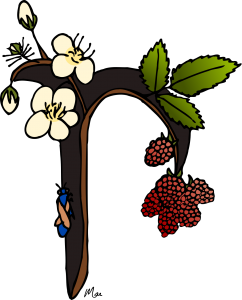
Strawberry
Strawberry (Fragraria spp.) is pollinated by sweat bees (Halictidae). The strawberries we eat today are a far cry from their pithy, woodland ancestors. Humans have domesticated the tiny, wild strawberry into the behemoths we find in stores, selecting for sweetness, juiciness, and fruit size along the way. Strawberries are not technically berries. Botanically speaking, a berry is a single ripened ovary like in watermelons or cucumbers. In strawberries, each bumpy seed on the surface of a fruit is actually a ripened ovary. For this reason, strawberries are termed aggregate fruits because they contain many ripened ovaries. Strawberries have perfect flowers that are varietally self-incompatible. Bee pollination is needed to increase fruit set and produce high quality, uniform fruits. Sweat bees have been found to be superior pollinators of strawberry to honey bees because they are better at depositing compatible pollen on stigmas. Top
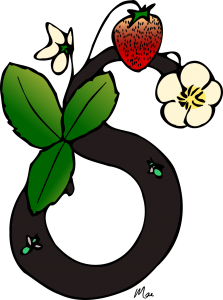
Tomato
Tomato (Solanum lycopersicum) is pollinated by bumble bees (Bombus spp.). Few fruits are as recognizable as tomatoes. Native to Central and South America, tomatoes have taken over the world thanks to our love for the fresh fruits and tomato-based sauces, stews, and curries. Tomatoes are grown in two ways—field and greenhouse—but always require buzz-pollination to set fruit. Field tomatoes are produced by a diverse suite of wild bees. Greenhouse tomatoes, instead, are exclusively pollinated by bumble bees. Bumble bees are reared in boxes suitable for global transport and easily deployed inside a greenhouse. Most of your grocery store tomatoes are produced this way. Even in places with native bumble bees, exotic managed bumble bees are still imported for the greenhouse pollination of tomatoes. Unfortunately, it is difficult to prevent bumble bees from escaping greenhouses. As a result, exotic bumble bee species have spread all over the world, threatening ecosystems. Top
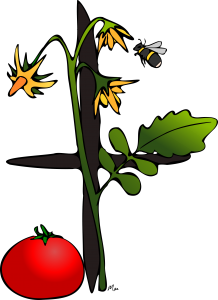
Ugli Fruit
Ugli Fruit (Citrus reticulata × paradisi) is pollinated by honey bees (Apis mellifera). Ugli fruit (and the associated UGLI trademark) is named for its blemished, off-putting rind, a shortcoming made up for by its few seeds and sweet, juicy flesh. Ugli fruit is a naturally occurring hybrid from Jamaica between three types of domesticated citrus: grapefruit, Seville orange, and tangerine. In fact, most of the citrus cultivars we enjoy, including grapefruit, are accidental hybrids, resulting from the cross-pollination of two compatible varieties that result in a pleasant combination. Honey bees are the chief pollinators of ugli fruit and are managed in Jamaica for its production. Top
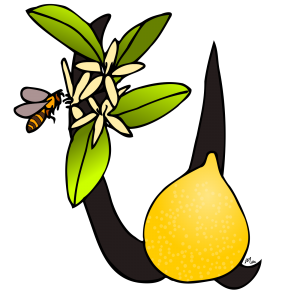
Vanilla
Vanilla (Vanilla planifolia) is pollinated by orchid bees (Euglossini). Vanilla is a finicky crop. It is a vining orchid that lives for ten years and flowers for just half of those years. Orchid bees are attracted to the showy vanilla flowers not for nectar, but for fragrance. Male orchid bees collect these fragrances and present them to female orchid bees as a sign of their quality. The male with the most diverse assortment of perfumes wins the lady. Upon leaving the flower, the male picks up a ball of pollen—a pollinium—containing millions of sticky pollen grains. When he visits another orchid flower to collect more fragrances, he’ll deposit the pollen. Orchid bees are native to the tropics of the Western Hemisphere. Vanilla is now widely grown in Madagascar, where orchid bees do not live, so flowers must be pollinated by hand. Clearly, the demand for vanilla is high enough to warrant such a labor-intensive (at times exploitative) practice. Top
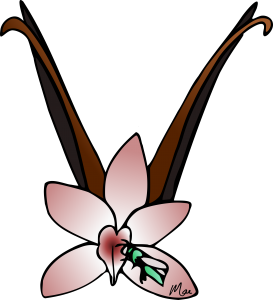
Watermelon
Watermelon (Citrunellus lanatus) is pollinated by bumble bees (Bombus spp.). The next time you sink your teeth into a slice of watermelon, thank bees. Watermelon is wholly dependent on bees to set fruit. In California, where festivals celebrate this fruit, over twenty-three species of bees have been documented to visit watermelon flowers. Bumble bees are stalwart pollinators, but long-horned bees, sweat bees, and squash bees are also excellent. Natural areas close to watermelon farms provide habitat for these wild pollinators and help ensure a high fruit set. Pollination results in seed set, but just because seedless watermelons lack seeds, it doesn’t mean they’re not pollinated. A discovery in the 1950s found that a pollination event combining two genetic varieties of watermelon resulted in a sweet, but seedless fruit. This discovery is merely the latest development in a long history of watermelon domestication that has been going on for over 5000 years. Top
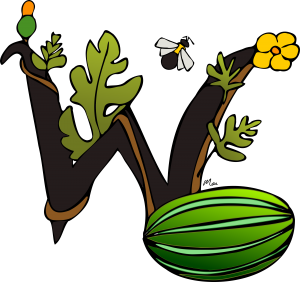
Ximenia
Ximenia (Ximenia americana) is pollinated by potter wasps (Eumeninae). Ximenia is a little-known wild fruit native to coastal, sandy plains of Florida. Ximenia produces edible fruits and is being investigated as a potential source of biofuel. Potter wasps visit ximenia flowers for nectar. After drinking their fill, and pollinating in the process, potter wasps go out in search of soft-bodied insects like caterpillars to catch and feed to their offspring. They will return to their mud nests with the paralyzed insects, stuffing several insects in the nest for her offspring. When the female wasp is satisfied that she’s collected enough, she’ll lay an egg on the insects and seal the nest. Ximenia is pollinated by bees too, but it’s a great example of how fruits can be produced by wasps too. Top
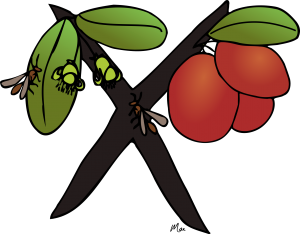
Yucca
Yucca (Yucca spp.) is pollinated by yucca moths (Prodoxidae). Yucca are distinctive plants—the most well known being Joshua trees—that thrive in dry, sandy areas. They may sound yucky, but yucca fruits are edible and they were an important part of native peoples’ diets*. Nowadays, yucca fruits are only found in the wild or in ornamental landscapes, where they rely on a curious little moth for pollination. After mating, a female yucca moth seeks out a yucca flower. Although most pollination is unintentional, a female yucca moth will intentionally collect a ball of pollen from yucca anthers, which she then places on the stigma of another flower. She lays an egg in the fertilized ovary. Her presence in the flower signals to other yucca moths to steer clear; too many eggs laid in one flower will cause the fruit to fail. Her egg then hatches into a larva that eats the developing seeds. A few seeds remain uneaten so the plant can propagate. What a remarkable example of mutualism! Neither the moth nor the plant could exist without the other. Top
*Yucca is not to be confused with yuca, i.e. cassava, which is an unrelated cash crop grown for its starchy root.
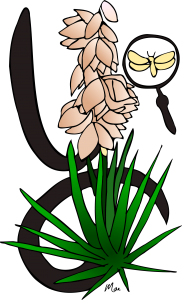
Zucchini
Zucchini (Cucurbita pepo) is pollinated by squash bees (Eucera pruinosa). Too many zucchinis might be the bane of gardeners, but not squash bees. Bright yellow squash flowers open at dawn and the bees wake early to ensure they are the first on the scene. They have to work fast since each flower is open for just one day. Males move between flowers, seeking mates and pollinating in the process. Females repeatedly visit squash flowers for pollen and nectar to feed her babies in the underground nest. By 10am, every squash flower has received enough pollen to produce fruit. Squash bees have a remarkable penchant for squash flowers. Over thousands of years, as humans traded and planted squash from its native range in Mexico to Maine, squash bees followed close behind. Nowadays, it is rare to find a squash plant in New England without a squash bee. Look in your garden in late summer for males sleeping in the closed flowers. Top
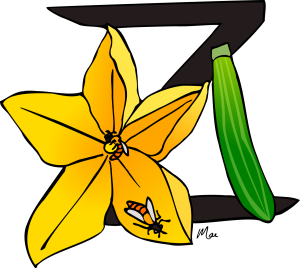
Glossary
Anther: the pollen factory, pollen must be picked up from anthers by an animal; male flower organ
Buzz-pollination: sonication, the process by which a bee vibrates its flight muscles in order to release pollen from anthers, required for crops in Ericaceae family (blueberries, cranberries) and Solanaceae family (tomatoes, eggplants, and chili peppers)
Dioecious: “two houses”, male and female flowers occur on separate plants
Fruit set: the number of flowers that become fruits
Inflorescence: a collection of flowers
Monoecious: “one house”, male and female flowers occur within the same plant
Ovary: the destination of pollen, must be successfully fertilized by male sex cells for seeds to be produced; female flower organ
Perfect flower: hermaphrodite, one flower contains both male and female parts
Self-compatible: pollination can occur with pollen from the same individual as the ovary, insect pollinators are not needed for (but sometimes enhance) fruit set on self-compatible plants
Self-incompatible: pollination cannot occur with self-pollen, stigma must receive pollen from a genetically different individual
Stigma: “landing pad” for pollen, pollen must land on a stigma for pollination to occur; female flower organ

